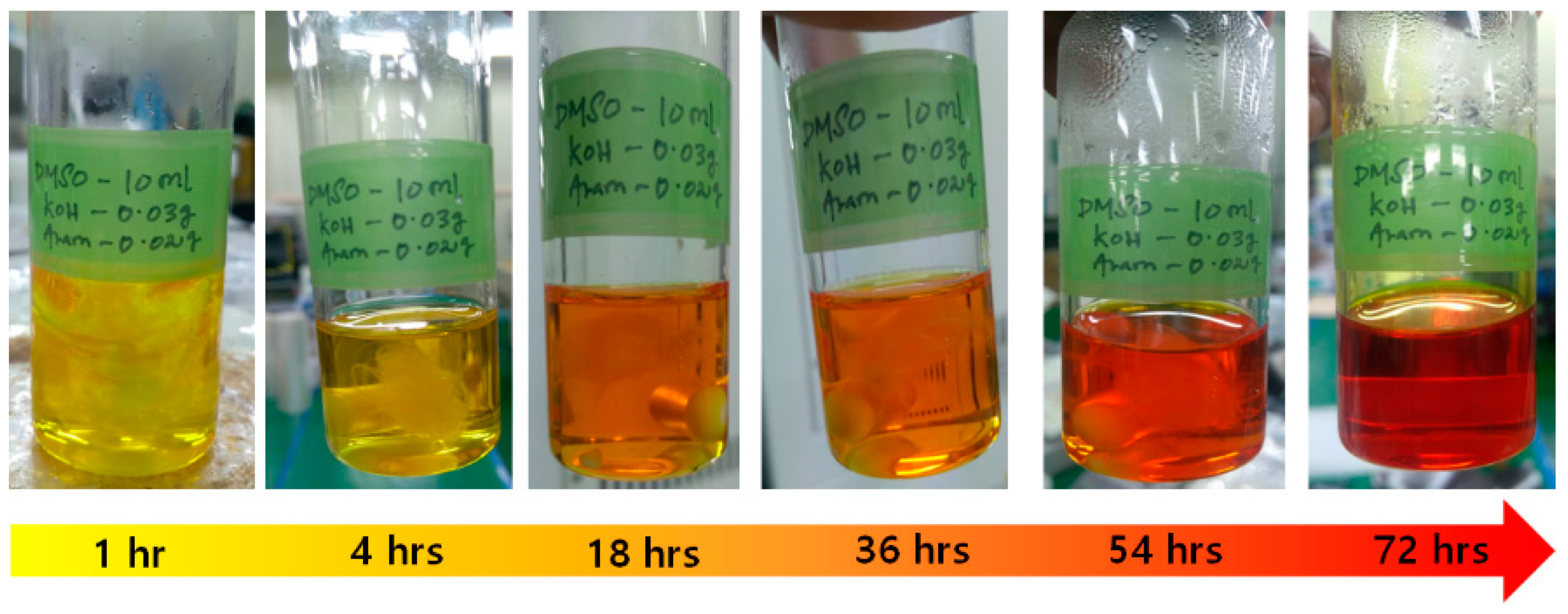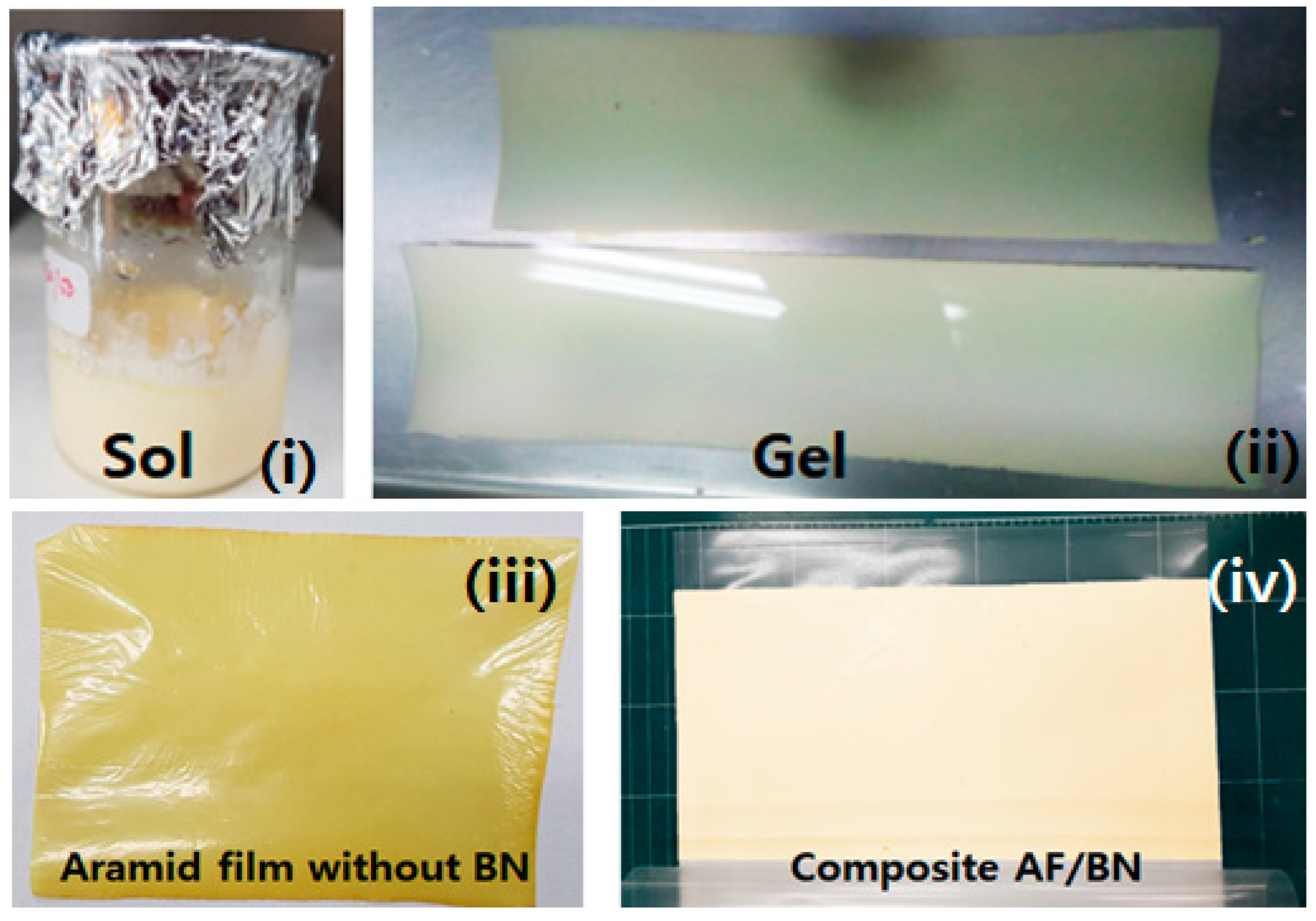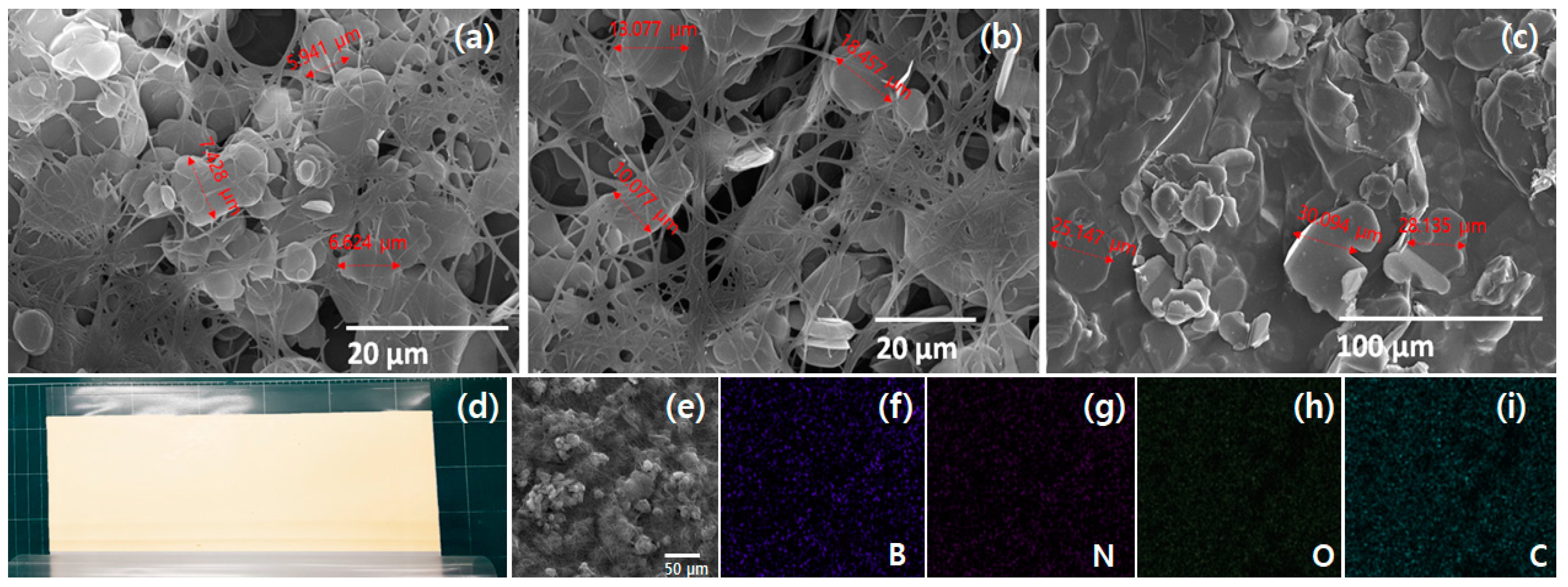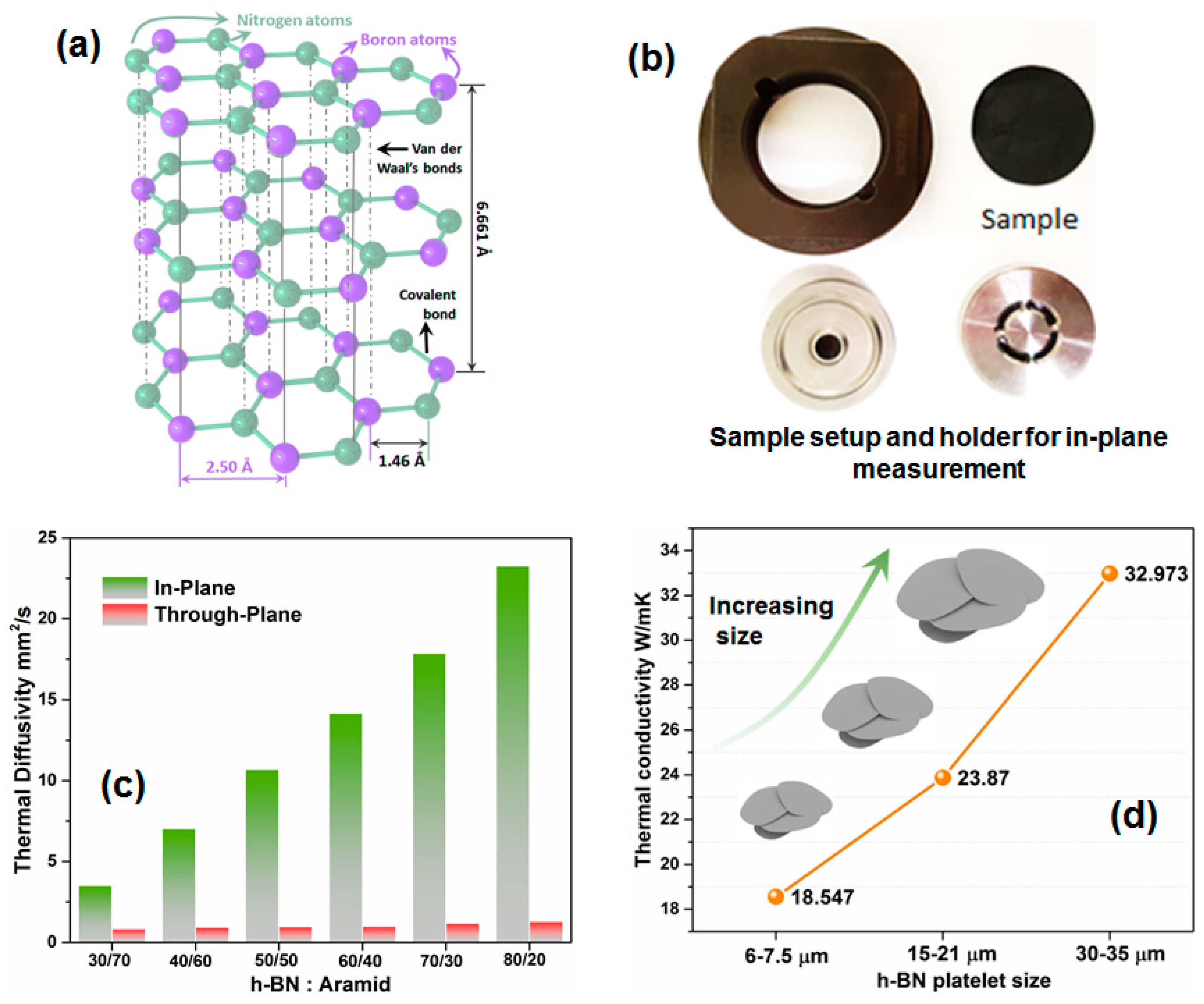Durable, Low-Cost, and Efficient Heat Spreader Design from Scrap Aramid Fibers and Hexagonal Boron Nitride
Abstract
:1. Introduction
2. Materials and Method
3. Characterization
4. Results and Discussion
5. Conclusions
Author Contributions
Funding
Institutional Review Board Statement
Informed Consent Statement
Data Availability Statement
Conflicts of Interest
References
- Kitahara, H.; Oku, T. Nanostructures and electronic properties of carbon and boron nitride nanocapsules. J. Ceram. Process. Res. 2004, 5, 89–93. [Google Scholar]
- Alazzam, M.B.; Hajjej, F.; AlGhamdi, A.S.; Ayouni, S.; Rahman, M.A. Mechanics of materials natural fibers technology on thermal properties of polymer. Adv. Mater. Sci. Eng. 2022, 2022, 1–5. [Google Scholar] [CrossRef]
- Kugimoto, H.; Uehara, M.; Enomoto, N.; Hojo, J. Rod-like Si3N4 grain growth in the sintered body of amorphous Si3N4-BN composite powder with sintering additives. J. Ceram. Process. Res. 2003, 4, 6–9. [Google Scholar]
- Kim, D.; Lee, Y.; Chacón, A.; Kim, D.-E. Effect of interlayer coupling and symmetry on high-order harmonic generation from monolayer and bilayer hexagonal boron nitride. Symmetry 2022, 14, 84. [Google Scholar] [CrossRef]
- Besisa, D.H.; Hagras, M.A.; Ewais, E.M.; Ahmed, Y.M.; Zaki, Z.I.; Ahmed, A.J. Low temperature synthesis of nano-crystalline h-boron nitride from boric acid/urea precursors. J. Ceram. Process. Researc 2016, 17, 1219–1225. [Google Scholar]
- Fu, L.; Wang, T.; Yu, J.; Dai, W.; Sun, H.; Liu, Z.; Sun, R.; Jiang, N.; Yu, A.; Lin, C.-T. An ultrathin high-performance heat spreader fabricated with hydroxylated boron nitride nanosheets. J. 2D Mater. 2017, 4, 025047. [Google Scholar] [CrossRef]
- Chen, H.; Ginzburg, V.V.; Yang, J.; Yang, Y.; Liu, W.; Huang, Y.; Du, L.; Chen, B. Thermal conductivity of polymer-based composites: Fundamentals and applications. Prog. Polym. Sci. 2016, 59, 41–85. [Google Scholar] [CrossRef]
- Lim, C.S.; Ryu, J.H.; Kim, D.-H.; Cho, S.-Y.; Oh, W.-C. Reaction morphology and the effect of pH on the preparation of TiO2 nanoparticles by a sol-gel method. J. Ceram. Process. Res. 2010, 11, 736–741. [Google Scholar]
- Wang, Y.; Xia, S.; Xiao, G.; Di, J.; Wang, J. High-loading boron nitride-based bio-inspired paper with plastic-like ductility and metal-like thermal conductivity. ACS Appl. Mater. Interfaces 2020, 12, 13156–13164. [Google Scholar] [CrossRef]
- Švec, P.J. Microstructure and mechanical properties of B4C-TiB2 ceramic composites hot pressed with in-situ reaction. J. Ceram. Process. Res. 2019, 20, 113–120. [Google Scholar] [CrossRef]
- Zhong, J.; Feng, Y.; Wang, H.; Hu, D. Fabrication and characterization of hexagonal boron nitride powder by a precursor conversion method. J. Ceram. Process. Res. 2013, 14, 269–273. [Google Scholar]
- Ning, Z.; Huan, L.; Tianwen, Z.; Hongmin, K.; Xiaoyang, W.; Xingyu, C. Effects of boron source composition ratio on the microstructure and adsorption performance of hexagonal boron nitride prepared by template method. J. Ceram. Process. Res. 2016, 17, 181–185. [Google Scholar]
- Liu, L.; Shen, S.; Wang, Y. Enhanced thermal conductivity of flexible h-BN/polyimide composites films with ethyl cellulose. e-Polymers 2019, 19, 305–312. [Google Scholar] [CrossRef]
- Chen, L.; Xu, H.-F.; He, S.-J.; Du, Y.-H.; Yu, N.-J.; Du, X.-Z.; Lin, J.; Nazarenko, S. Thermal conductivity performance of polypropylene composites filled with polydopamine-functionalized hexagonal boron nitride. PLoS ONE 2017, 12, e0170523. [Google Scholar] [CrossRef] [PubMed] [Green Version]
- Sayam, A.; Rahman, A.; Rahman, M.; Smriti, S.A.; Ahmed, F.; Rabbi, M.; Hossain, M.; Faruque, M. A review on carbon fiber-reinforced hierarchical composites: Mechanical performance, manufacturing process, structural applications and allied challenges. Carbon Lett. 2022, 32, 1–33. [Google Scholar] [CrossRef]
- Li, T.-L.; Hsu, S.L.-C. Enhanced thermal conductivity of polyimide films via a hybrid of micro-and nano-sized boron nitride. J. Phys. Chem. B 2010, 114, 6825–6829. [Google Scholar] [CrossRef]
- Moradi, S.; Román, F.; Calventus, Y.; Hutchinson, J. Remarkable Thermal Conductivity of Epoxy Composites Filled with Boron Nitride and Cured under Pressure. Polymers 2021, 13, 955. [Google Scholar] [CrossRef]
- Pramono, A.E.; Nura, M.Z.; Soedarsonob, J.; Indayaningsih, N. Properties of wear rate and electrical conductivity of carbon ceramic composites. J. Ceram. Process. Res. 2019, 20, 1–7. [Google Scholar] [CrossRef]
- Antunes, M.; Realinho, V.; Velasco, J.I.; Solórzano, E.; Rodríguez-Pérez, M.-Á.; de Saja, J.A. Thermal conductivity anisotropy in polypropylene foams prepared by supercritical CO2 dissolution. Mater. Chem. Phys. 2012, 136, 268–276. [Google Scholar] [CrossRef]
- Ferreira, F.; Franceschi, W.; Menezes, B.; Brito, F.; Lozano, K.; Coutinho, A.; Cividanes, L.; Thim, G. Dodecylamine functionalization of carbon nanotubes to improve dispersion, thermal and mechanical properties of polyethylene based nanocomposites. Appl. Surf. Sci. 2017, 410, 267–277. [Google Scholar] [CrossRef]
- Muratov, D.; Kuznetsov, D.; Il’Inykh, I.; Mazov, I.; Stepashkin, A.; Tcherdyntsev, V. Thermal conductivity of polypropylene filled with inorganic particles. J. Alloy. Compd. 2014, 586, S451–S454. [Google Scholar] [CrossRef]
- Yang, C.; Navarro, M.; Zhao, B.; Leng, G.; Xu, G.; Wang, L.; Jin, Y.; Ding, Y. Thermal conductivity enhancement of recycled high density polyethylene as a storage media for latent heat thermal energy storage. Sol. Energy Mater. Sol. Cells 2016, 152, 103–110. [Google Scholar] [CrossRef]
- Cao, J.-P.; Zhao, J.; Zhao, X.; You, F.; Yu, H.; Hu, G.-H.; Dang, Z.-M. High thermal conductivity and high electrical resistivity of poly (vinylidene fluoride)/polystyrene blends by controlling the localization of hybrid fillers. Compos. Sci. Technol. 2013, 89, 142–148. [Google Scholar] [CrossRef]
- Guo, Y.; Ruan, K.; Shi, X.; Yang, X.; Gu, J. Factors affecting thermal conductivities of the polymers and polymer composites: A review. Compos. Sci. Technol. 2020, 193, 108134. [Google Scholar] [CrossRef]
- Kiran, V.; Gaur, B. Curing and thermal behavior of epoxy resins of hexafluoro-bisphenol–A and bisphenol-A. Polímeros 2016, 26, 11–20. [Google Scholar] [CrossRef]
- Messina, E.; Leone, N.; Foti, A.; Di Marco, G.; Riccucci, C.; Di Carlo, G.; Di Maggio, F.; Cassata, A.; Gargano, L.; D’Andrea, C. Double-wall nanotubes and graphene nanoplatelets for hybrid conductive adhesives with enhanced thermal and electrical conductivity. ACS Appl. Mater. Interfaces 2016, 8, 23244–23259. [Google Scholar] [CrossRef] [PubMed]
- Singh, A.K.; Panda, B.P.; Mohanty, S.; Nayak, S.K.; Gupta, M.K. Recent developments on epoxy-based thermally conductive adhesives (TCA): A review. Polym.-Plast. Technol. Eng. 2018, 57, 903–934. [Google Scholar] [CrossRef]
- Liu, B.; Li, Y.; Fei, T.; Han, S.; Xia, C.; Shan, Z.; Jiang, J. Highly thermally conductive polystyrene/polypropylene/boron nitride composites with 3D segregated structure prepared by solution-mixing and hot-pressing method. Chem. Eng. J. 2020, 385, 123829. [Google Scholar] [CrossRef]
- Mrajji, O.; El Wazna, M.; Ouhaibi, S.; Sair, S.; El Bouari, A.; Cherkaoui, O.; Belouaggadia, N. Thermal Performance of Building Materials Based on Feather and Polystyrene Wastes; IOP Conference Series: Materials Science and Engineering; IOP Publishing: Bristol, UK, 2020; p. 012010. [Google Scholar]
- Souza, M.K.; Lima, E.P.; Nascimento, I.V.; Montazerian, M.; Baino, F.; Fook, M.V. Development, characterization and optimization of a new bone cement based on calcium–Strontium aluminates and chitosan-glycerin solution. Ceram. Int. 2022, 48, 31866–31879. [Google Scholar] [CrossRef]
- Uher, C. Thermal conductivity of high-T c superconductors. J. Supercond. 1990, 3, 337–389. [Google Scholar] [CrossRef]
- Burger, N.; Laachachi, A.; Ferriol, M.; Lutz, M.; Toniazzo, V.; Ruch, D. Review of thermal conductivity in composites: Mechanisms, parameters and theory. Prog. Polym. Sci. 2016, 61, 1–28. [Google Scholar] [CrossRef]
- Zhai, S.; Zhang, P.; Xian, Y.; Zeng, J.; Shi, B. Effective thermal conductivity of polymer composites: Theoretical models and simulation models. Int. J. Heat Mass Transf. 2018, 117, 358–374. [Google Scholar] [CrossRef]
- Shimizu, Y.; Ishii, J.; Shinzato, K.; Baba, T. A novel method for determination of the thermal diffusivity of thin films using a modulated CO2 laser. Int. J. Thermophys. 2005, 26, 203–211. [Google Scholar] [CrossRef]
- Yang, M.; Cao, K.; Sui, L.; Qi, Y.; Zhu, J.; Waas, A.; Arruda, E.M.; Kieffer, J.; Thouless, M.; Kotov, N.A. Dispersions of aramid nanofibers: A new nanoscale building block. ACS Nano 2011, 5, 6945–6954. [Google Scholar] [CrossRef] [Green Version]
- Hammer, C. Cooperative molecular motion in blends of poly (vinyl chloride) with ethylene-vinyl acetate copolymers. Macromolecules 1971, 4, 69–71. [Google Scholar] [CrossRef]
- ATALA, M.; GÜL AYGÜN, E.; Doğan, A. Evaluation of the crack formation of feldspathic ceramic reinforced with bor chemicals. J. Ceram. Process. Res. 2020, 21, 407–415. [Google Scholar]
- Liu, Z.; Li, J.; Liu, X. Novel functionalized BN nanosheets/epoxy composites with advanced thermal conductivity and mechanical properties. ACS Appl. Mater. Interfaces 2020, 12, 6503–6515. [Google Scholar] [CrossRef]
- Kim, H.; Jeon, D.-Y.; Jang, S.G.; Lee, M.W. Synergetic effect of BN for the electrical conductivity of CNT/PAN composite fiber. J. Mech. Sci. Technol. 2022, 36, 3103–3107. [Google Scholar] [CrossRef]
- Yoo, J.-H.; Maiyalagan, T.; Yi, S.C. Thermal conductive thin, flexible composite sheet of boron nitride aggregates and alumina for enhanced through plane conductivity. Ceram. Int. 2022, 48, 29183–29189. [Google Scholar] [CrossRef]
- Chen, Y.; Zhang, H.; Chen, J.; Guo, Y.; Jiang, P.; Gao, F.; Bao, H.; Huang, X. Thermally Conductive but Electrically Insulating Polybenzazole Nanofiber/Boron Nitride Nanosheets Nanocomposite Paper for Heat Dissipation of 5G Base Stations and Transformers. ACS Nano 2022, 16, 14323–14333. [Google Scholar] [CrossRef]
- Yin, C.-G.; Liu, Z.-J.; Mo, R.; Fan, J.-C.; Shi, P.-H.; Xu, Q.-J.; Min, Y.-L. Copper nanowires embedded in boron nitride nanosheet-polymer composites with enhanced thermal conductivities for thermal management. Polymer 2020, 195, 122455. [Google Scholar] [CrossRef]
- Wu, K.; Fang, J.; Ma, J.; Huang, R.; Chai, S.; Chen, F.; Fu, Q. Achieving a Collapsible, Strong, and Highly Thermally Conductive Film Based on Oriented Functionalized Boron Nitride Nanosheets and Cellulose Nanofiber. ACS Appl. Mater. Interfaces 2017, 9, 30035–30045. [Google Scholar] [CrossRef] [PubMed]
- Yao, Y.; Zeng, X.; Wang, F.; Sun, R.; Xu, J.-b.; Wong, C.-P. Significant Enhancement of Thermal Conductivity in Bioinspired Freestanding Boron Nitride Papers Filled with Graphene Oxide. Chem. Mater. 2016, 28, 1049–1057. [Google Scholar] [CrossRef]
- Li, P.; Shen, H.; Qian, Z.; Yang, X.; Zhao, N.; Zhu, C.; Xu, J. Facile fabrication of flexible layered GO/BNNS composite films with high thermal conductivity. J. Mater. Sci. 2018, 53, 4189–4198. [Google Scholar] [CrossRef]
- Rahman, M.M.; Puthirath, A.B.; Adumbumkulath, A.; Tsafack, T.; Robatjazi, H.; Barnes, M.; Wang, Z.; Kommandur, S.; Susarla, S.; Sajadi, S.M.; et al. Fiber reinforced layered dielectric nanocomposite. Adv. Funct. Mater. 2019, 29, 1900056. [Google Scholar] [CrossRef]







| Parameters | Through Plane | In-Plane |
|---|---|---|
| Detection size | 12.5 mm | 24.80 mm |
| Sample coating | Graphite | Graphite |
| Voltage | 260 V | 250 V |
| Duration | 2000 ms | 4000 ms |
| Pulse width | 30 μs | 50 μs |
| Main gain | 5087 | 5087 |
| Composite | k (W/mK) | Reference |
|---|---|---|
| f-BNNS/PVA 90/10 | 4.5 | [41] |
| BN/PVA 57/43 | 7.47 | [42] |
| f-BNNS/CNF 70/30 | 30.25 | [43] |
| BNNS/GO 95/5 | 29.8 | [44] |
| BNNS/GO | 11.9 | [45] |
| ANF/BNNS 90/10 | 2.4 | [46] |
| AF/BN | 32.973 | This work |
Publisher’s Note: MDPI stays neutral with regard to jurisdictional claims in published maps and institutional affiliations. |
© 2022 by the authors. Licensee MDPI, Basel, Switzerland. This article is an open access article distributed under the terms and conditions of the Creative Commons Attribution (CC BY) license (https://creativecommons.org/licenses/by/4.0/).
Share and Cite
Yoo, J.-H.; Yi, S.C. Durable, Low-Cost, and Efficient Heat Spreader Design from Scrap Aramid Fibers and Hexagonal Boron Nitride. Symmetry 2022, 14, 2597. https://doi.org/10.3390/sym14122597
Yoo J-H, Yi SC. Durable, Low-Cost, and Efficient Heat Spreader Design from Scrap Aramid Fibers and Hexagonal Boron Nitride. Symmetry. 2022; 14(12):2597. https://doi.org/10.3390/sym14122597
Chicago/Turabian StyleYoo, Jung-Hun, and Sung Chul Yi. 2022. "Durable, Low-Cost, and Efficient Heat Spreader Design from Scrap Aramid Fibers and Hexagonal Boron Nitride" Symmetry 14, no. 12: 2597. https://doi.org/10.3390/sym14122597






